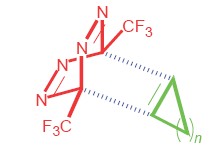| [1] Diels, O.; Alder, K. Justus Liebig's Annalen der Chemie 1928, 460, 98. [2] Wiberg, K. B.; Bartley, W. J. J. J. Am. Chem. Soc. 1960, 82, 6375. [3] Lou, Y.; Horikawa, M.; Kloster, R. A.; Hawryluk, N. A.; Corey, E. J. J. Am. Chem. Soc. 2004, 126, 8916. [4] Cadogan, J. I. G.; Cameron, D. K.; Gosney, I.; Tinley, E. J.; Wyse, S. J.; Amaro, A. J. Chem. Soc., Perkin Trans. 1 1991, 2081. [5] Brúson, H. A.; Riener, T. W. J. Am. Chem. Soc. 1945, 67, 723. [6] Rubin, M.; Rubina, M.; Gevorgyan, V. Synthesis 2006, 1221. [7] Zhu, Z.-B.; Wei, Y.; Shi, M. Chem. Soc. Rev. 2011, 40, 5534. [8] Wilson, M. R.; Taylor, R. E. Angew. Chem., Int. Ed. 2013, 52, 4078. [9] Liu, F.; Paton, R. S.; Kim, S.; Liang, Y.; Houk, K. N. J. Am. Chem. Soc. 2013, 135, 15642. [10] Jorgensen, W. L.; Lim, D.; Blake, J. F. J. Am. Chem. Soc. 1993, 115, 2936. [11] Beno, B. R.; Wilsey, S.; Houk, K. N. J. Am. Chem. Soc. 1999, 121, 4816. [12] Wilsey, S.; Houk, K. N.; Zewail, A. H. J. Am. Chem. Soc. 1999, 121, 5772. [13] Diau, E. W.-G.; De Feyter, S.; Zewail, A. H. Chem. Phys. Lett. 1999, 304, 134. [14] Singleton, D. A.; Schulmeier, B. E.; Hang, C.; Thomas, A. A.; Leung, S.-W.; Merrigan, S. R. Tetrahedron 2001, 57, 5149. [15] Dinadayalane, T. C.; Vijaya, R.; Smitha, A.; Narahari Sastry, G. J. Phys. Chem. A 2002, 106, 1627. [16] Guner, V.; Khuong, K. S.; Leach, A. G.; Lee, P. S.; Bartberger, M. D.; Houk, K. N. J. Phys. Chem. A 2003, 107, 11445. [17] Thalhammer, F.; Wallfahrer, U.; Sauer, J. Tetrahedron Lett. 1990, 31, 6851. [18] Hu, G. D.; Zhang, S. L.; Zhang, Q. G. Acta Chim. Sinica 2009, 67, 1019. (扈国栋, 张少龙, 张庆刚, 化学学报, 2009, 67, 1019.) [19] Ma, G. Z.; Liu, C.; Qiu, Y. F.; Nan, J. M. Acta Chim. Sinica 2009, 67, 453. (马国正, 刘聪, 求亚芳, 南俊民, 化学学报, 2009, 67, 453.) [20] Yi, C. H.; Zhang, Q. G. Acta Chim. Sinica 2010, 68, 2029. (伊长虹, 张庆刚, 化学学报, 2010, 68, 2029.) [21] Gurney, R. W. Introduction to Statistical Mechanics, 1st ed., McGraw-Hill Book Company, New York, 1949. [22] Frank, H. S. J. Chem. Phys. 1945, 13, 478. [23] Mardirossian, N.; Head-Gordon, M. J. Chem. Theory Comput. 2013, 9, 4453. [24] Chen, Y.-M.; Chass, G. A.; Fang, D.-C. Phys. Chem. Chem. Phys. 2014, 16, 1078. [25] Lee, C.; Yang, W.; Parr, R. G. Phys. Rev. B 1988, 37, 785. [26] Yanai, T.; Tew, D.; Handy, N. Chem. Phys. Lett. 2004, 393, 51. [27] Xu, X.; Goddard, W. A. Ⅲ. Proc. Natl. Acad. Sci. U. S. A. 2004, 101, 2673. [28] Boese, A. D.; Martin, J. M. L. J. Chem. Phys. 2004, 121, 3405. [29] Tawada, Y.; Tsuneda, T.; Yanagisawa, S.; Yanai, T.; Hirao, K. J. Chem. Phys. 2004, 120, 8425. [30] Chai, J.-D.; Head-Gordon, M. J. Chem. Phys. 2008, 128, 084106. [31] Chai, J.-D.; Head-Gordon, M. Phys. Chem. Chem. Phys. 2008, 10, 6615. [32] Zhao, Y.; Truhlar, D. G. J. Phys. Chem. 2006, 110, 5121. [33] Peverati, R.; Truhlar, D. G. J. Phys. Chem. Lett. 2011, 2, 2810. [34] McLean, A. D.; Chandler, G. S. J. Chem. Phys. 1980, 72, 5639. [35] Miertus, S.; Scrocco, E.; Tomasi, J. Chem. Phys. 1981, 55, 117. [36] Tao, J.-Y.; Mu, W.-H.; Chass, G. A.; Tang, T.-H.; Fang, D.-C. Int. J. Quantum Chem. 2013, 113, 975. [37] Fang, D.-C. THERMO, Beijing Normal University, Beijing, China. [38] See http://gauss.fh-bielefeld.de/aim2000. |
